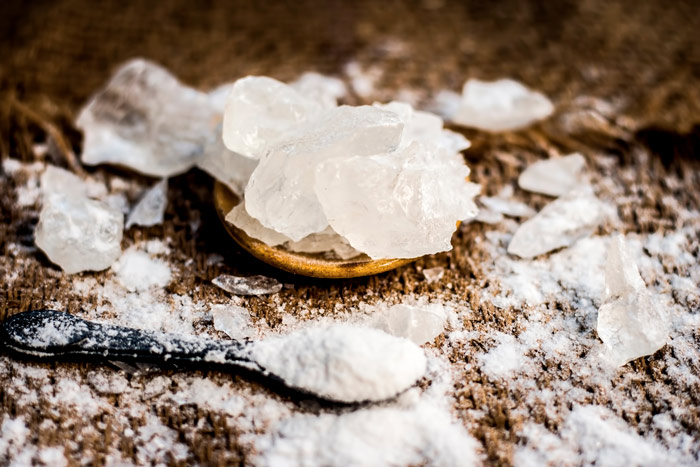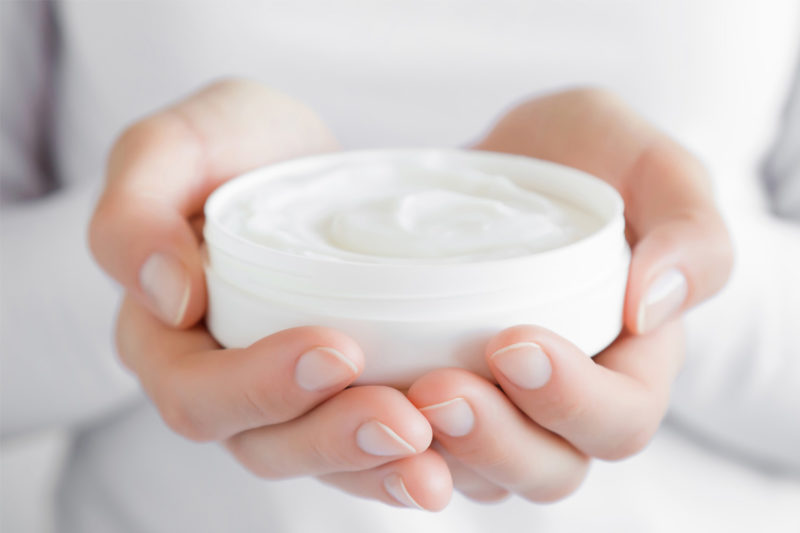It all started in 2005 with parabens, and the list has lengthened over the years. Ingredients are deemed suspect for various reasons. Here is a non-exhaustive list of the main controversial Ingredients that should be kept out of beauty product formulations.
First of all, bear in mind that in France, beauty products are governed by EU regulations, which are very strict and constantly changing as a result of studies carried out by groups of scientists within the European Scientific Committee for Consumer Safety (CSSC). Moreover, producers and brands, who are reactive to public opinion – and wanting to drive sales – often get ahead of legislation by dropping controversial ingredients. Also, it is important to categorise the reasons why these ingredients are under scrutiny. Some are problematic because they are not environmentally friendly, others because they can cause irritation or allergies. And lastly, there are those suspected of being endocrine disruptors or carcinogens.
BHT
BHA, which is classed as a “possible carcinogen” by the International Agency for Research on Cancer (IARC), is said to be reprotoxic and an endocrine disruptor, and is no longer used in beauty product formulations. However, the use of BHT is still widespread. It is used as an antioxidant to prevent fats in formulations from going rancid and perfumes from getting oxidised. Like BHA, it is suspected of being allergenic and neurotoxic, inducing a reactive state and of being an oestrogenic endocrine disruptor to blame for male fertility problems. Lasty, it is said to hang around in the body and the environment. ANSES has asked the EU authorities to reassess it.
Titanium dioxide
Titanium dioxide (E171) has been banned as a food additive since 1 January 2020. A study by the National Institute for Agricultural Research (INRA) raised fears that in “nano” form it could be carcinogenic if swallowed or inhaled. In beauty products, titanium dioxide, which is of mineral origin, is used as a white pigment in make-up, as an opacifier and especially as a filter in sunscreen. It is allowed in organic formulations, even in its nano form. On the skin, it poses no problem. However, it is prohibited in powders and sprays and poses a problem for the workers who handle it.
Chemical UV filters

Going without them is not an option, given the huge increase in skin cancer cases over the last 30 years. However, some chemical filters are under scrutiny for various reasons.
The first accusation is that of causing endocrine disruption. Although not proven, the following are suspected of doing so: avobenzone; ethylhexyl methoxycinnamate (octinoxate); benzophenone-1 and -3 (oxybenzone); octocrylene; 4-methylbenzylidene camphor (4-MBC); and homosalate.
Moreover, a study on octocrylene was conducted by researchers from the marine observatory in Banyuls-sur-Mer (Sorbonne University/CNRS) published in March 2021 in the journal Chemical Research in Toxicology. It showed that as soon as octocrylene is produced, a chemical reaction turns it into benzophenone – another potentially carcinogenic and endocrine-disrupting filter – and that the concentration in the finished product systematically increases over time. A great many brands dropped octocrylene from their products in 2022, as it has already been implicated in a cross-allergy with ketoprofen treatments.
However, according to the standards set by EU regulations the quantities applied, limited to a few months a year, are not a problem. But after being shed into water, and not filtered out by treatment plants, they are ingested by living organisms that end up in our plates…
Because that is the other complaint, and it is a sizeable one: the effect of chemical UV sunscreens on the environment. Because while they block UV rays on the skin, they also do so in the water. Thus, the thousands of tonnes of non-biodegradable filters shed into bathing waters every year prevent the sun’s rays from reaching the seabed and disrupt conditions for the organisms living there.
A great many studies have shown that these filters have a negative impact on marine organisms. In December 2018, a study by French researchers found that octocrylene accumulated in corals in the form of fatty acid derivatives and was capable of interfering with their metabolism. A study by Tel Aviv University researchers published in 2015 found that oxybenzone – AKA benzophenone – alters the morphology of coral larvae by damaging their DNA. Thus some chemical filters have been banned in tourist areas. In 2020 the archipelago of Palau was the first area to ban ten ingredients. They include oxybenzone (called benzophenone-3 on the INCI list) and octinoxate (ethylhexyl methoxycinnamate). These two chemical filters have also been banned in Hawaii since 1 January 2021. Territories with coral reefs, such as the US Virgin Islands and the Republic of the Marshall Islands, have banned octocrylene, too. Sometimes the use of sunscreen is prohibited, for example for those touring certain cenotes (caves/grottos) in Mexico and Lifou in New Caledonia.
Mineral oils
Mineral oils are derived from the distillation of petroleum after separation of the light combustible hydrocarbons (gas, petrol and oil). Found under names such as paraffinum liquidum, cera microcristallina, synthetic wax and petroleum jelly in the INCI, they are inert substances. They are used to add slip and shine to make-up products. They also constitute a film-forming emollient barrier in skincare products (body and hand balms, lip salves and foot creams) that prevents water loss. In addition to their petrochemical origin, they are also said to be pore-blocking and to cause, exacerbate or prolong acne breakouts.
Methylisothiazolinone (MIT) and methylchloroisothiazolinone (MCIT)
The scrutiny of parabens eventually led to that of methylisothiazolinone (MIT) and methylchloroisothiazolinone (MCIT). Hitherto used in small amounts, they suddenly became an alternative widely used by producers, causing irritation and allergies. Therefore, the health authorities banned the MCIT-MIT combination in non-rinse products from April 2016. Then the European Union banned the use of MIT alone in these same products from 12 February 2017.
Parabens
Since the “great paraben scandal” of 2005, these preservatives, which prevent the development of bacteria and mould in creams and all water-based products, are no longer considered harmless. Having been used in beauty products since 1920, they are also found in food products under the names E214 to E219. They are also found in a considerable number of medications, in much larger amounts than in beauty products. The most dangerous ones (isobutyl, isopropyl, benzyl, pentyl and phenylparaben) have been banned since 2014. Conversely, short-chain ethylparaben and methylparaben have been cleared by French and EU experts. That leaves propylparaben and butylparaben. These are suspected of being endocrine disruptors, and are banned from non-rinse products intended for children under the age of 3. Hence they are hardly used any longer, as their poor public image has led almost all beauty product brands to drop them. Yet toxicologists acknowledge that those parabens allowed (methyl, ethyl, propyl and butylparabens) are excellent broad-spectrum preservatives. They have very few side effects and a very good track record, unlike those used more recently.
PEGs
Various types of polyethylene glycol, used in formulations as emollients, emulsifiers or thickeners, are made from ethylene oxide, a highly reactive and toxic gas that is carcinogenic and mutagenic. So they are under fire for environmental reasons: the production method used and the fact that they are turn up in waste water.
Phenoxyethanol
Phenoxyethanol is a widely-used antibacterial and antimicrobial preservative that is very much under fire. First off, its processing includes ethoxylation, a polluting process that’s toxic for the workers who handle it. It is also a potential irritant, and can cause contact eczema. High-quantity studies have shown it to be hepatotoxic to mice. Lasty, it is suspected of being a carcinogen and endocrine disruptor. But no studies have borne out these suspicions, and the Scientific Committee on Consumer Safety, backed by the European Commission, has deemed it safe for all users.
Aluminium salts

Phenoxyethanol is a widely-used antibacterial and antimicrobial preservative that is very much under fire. First off, its processing includes ethoxylation, a polluting process that’s toxic for the workers who handle it. It is also a potential irritant, and can cause contact eczema. High-quantity studies have shown it to be hepatotoxic to mice. Lasty, it is suspected of being a carcinogen and endocrine disruptor. But no studies have borne out these suspicions, and the Scientific Committee on Consumer Safety, backed by the European Commission, has deemed it safe for all users.
Silicones
These silica derivatives – going by the names dimethicone, dimethiconol or those ending in ‘siloxane’ – are widely used for the silky or powdery feel that they impart to skincare and make-up products. That slip in shampoos, masks and serums also eases application, detangles, coats and adds shine to the hair.
The problem is that they are not very biodegradable, even though their toxicological effects are thought to be minimal. On the one hand, they are criticised for their tendency to build up. They do so on the hair (it would take more than a month to get rid of them completely) without caring for it, and ultimately prevent dyes and perming agents from penetrating the hair properly. They are also thought to block the skin’s pores. As far as their biodegradability problem is concerned, new-generation silicones are appearing. They are light and water-soluble, with smaller effective quantities to avoid that cloying, comedogenic effect. They also break down much better in the natural environment.
In addition, two volatile silicones – cyclotetrasiloxane (D4) and cyclopentasiloxane (D5) have been limited to 0.1% in rinsed products since January 2020. They are suspected of being endocrine disruptors, in particular for aquatic organisms, as well as being recognised as toxins that build up and hang around in the body.
Sulphates
These are foaming agents – anionic surfactants – that form masses of lather and cleanse very effectively. They are very cheap, and found in shampoos, shower gels, liquid soaps and also all laundry detergents. You’ll find them under the names sodium laureth sulphate (the most commonplace) and ammonium lauryl sulphate (which is allowed in organic products). More than anything, they come under fire for being very harsh, being potential irritants, fading out hair dyes and disrupting the scalp’s microbiota. Moreover, “laureth” calls for ethoxylation, a polluting process, which accounts for its being banned from organic products.







